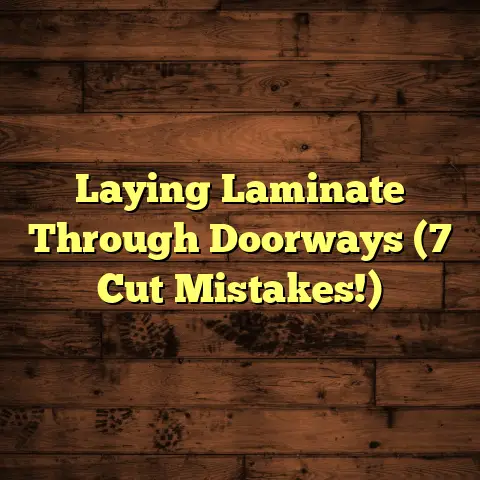How To Install Stainmaster Vinyl Plank Flooring? (Explained)
Installing Stainmaster vinyl plank flooring can seem like a daunting challenge at first.
I remember the first time I decided to tackle this project; I felt a mix of excitement and apprehension.
Would I get it right?
Would it turn out to be the upgrade my home desperately needed?
With years of experience under my belt, I’ve come to appreciate the beauty and practicality of vinyl plank flooring.
Let me walk you through my journey, sharing insights, tips, and even some hurdles I faced along the way.
Preparing for Installation
Before you even think about laying down those beautiful planks, preparation is key.
Here’s how I approach it:
Gather Your Tools
Make sure you have the following tools handy:
- Measuring tape
- Utility knife
- T-square
- Pull bar
- Hammer
- Spacers
- Level
- Flooring underlayment (if required)
- Vacuum Cleaner
- Broom
- Moisture Barrier (if installing in a basement)
Having everything organized makes the process smoother.
I often lay out my tools in a designated area near the installation site for easy access.
Measuring the Space
I always start by measuring the area where I’ll install the flooring.
This not only helps determine how much material I need but also gives me an idea of how much time I’ll spend on the project.
For example, if your room measures 12 feet by 15 feet, you’ll want to calculate the square footage (180 sq ft) and add about 10% for waste.
I usually grab a notepad to jot down my measurements.
It’s surprising how easy it is to forget details when you’re knee-deep in a project!
Choosing the Right Underlayment
Stainmaster vinyl planks often come with a built-in underlayment, but if yours doesn’t, choose wisely.
Underlayment can help with sound absorption and provide a bit of cushioning underfoot.
I’ve used various types in different projects; foam underlayment is my go-to for living spaces, while moisture-resistant options are ideal for basements or kitchens.
For example, when installing vinyl planks in a kitchen, I chose a high-density foam underlayment that not only absorbed sound but also provided additional thermal insulation—something that made a noticeable difference during colder months.
Acclimating the Planks
One crucial step is to acclimate the planks to the room’s temperature and humidity.
I typically leave them in the space for at least 48 hours before installation.
This prevents expansion or contraction after they’re laid down.
I remember one winter when I neglected this step; the planks expanded after installation due to sudden temperature changes.
It was a learning experience that taught me never to skip this part again.
Cost Estimation with FloorTally
Once I have my measurements and materials sorted out, I turn to FloorTally for cost estimation.
This tool has made budgeting so much easier for me.
It pulls local material and labor rates, allowing me to create accurate estimates without juggling multiple spreadsheets or quotes.
For instance, when I last installed Stainmaster vinyl plank flooring in a 200 sq ft area, FloorTally helped me estimate costs effectively.
The total came to about $1,800, which included materials, underlayment, and labor.
This level of transparency has been invaluable in building trust with my clients.
It’s worth mentioning that FloorTally also lets me input different scenarios.
If I decide on a higher-end material or want to consider hiring extra help, I can see how those changes affect my budget instantly.
This flexibility has been crucial for managing client expectations and ensuring projects remain within their financial limits.
Installation Process
Now for the fun part—installing the planks!
Here’s how I tackle it step by step:
Preparing the Subfloor
A clean and dry subfloor is essential.
I make sure to sweep or vacuum the area thoroughly.
If there are any imperfections, like low spots or bumps, I’ll use a leveling compound to create a smooth surface.
A couple of months ago, while working on a residential project, I found that the original hardwood floor had some uneven spots.
It took a bit more time to level the subfloor, but in the end, it made a world of difference when laying down the vinyl planks.
Laying Down the Planks
- Start in a corner: I usually start in a corner farthest from the entrance and lay the first plank with the tongue side facing the wall.
- Leave Expansion Gaps: Using spacers, I ensure there’s a gap of about 1/4 inch between the planks and the wall.
This allows for expansion. - Continue Laying Rows: For subsequent rows, I stagger the seams by cutting the first plank of each row to different lengths.
This not only looks better but enhances stability. - Clicking Them Together: Stainmaster vinyl planks are designed to snap together easily.
When I click them into place, I use a pull bar and hammer to ensure a snug fit without damaging the edges. - Trimming at Doorways: For doorways or transitions, I trim the planks to fit around thresholds carefully.
A jigsaw usually does the trick. - Using a Level: Throughout the installation, I keep my level handy to check that everything remains even.
It’s tempting to skip this step when you’re excited about finishing up, but trust me—a little diligence here saves headaches later on. - Finishing Touches: Once all planks are laid, I check for any loose ends or misaligned areas before moving on to removing spacers and installing baseboards or quarter rounds to cover any gaps at the edges.
Finalizing the Installation
After laying all the planks, I remove spacers and install baseboards or quarter rounds to cover any gaps at the edges.
It’s that finishing touch that truly completes the look.
Challenges Along the Way
Despite my experience, challenges can still arise during installation.
Once, while working on a project in a client’s home, we discovered that one section of the subfloor was slightly damp due to a leak from a nearby pipe.
It was a setback that delayed our progress by a day while we addressed the issue.
I’ve also had instances where miscalculating materials led to last-minute trips to the store.
This is where FloorTally shines again; it helps me avoid such mishaps by providing accurate estimates upfront.
Dealing with Imperfections
There have been times when I’ve encountered imperfect planks right out of the box—scratches or inconsistencies that could compromise an otherwise flawless installation.
In those situations, I’ve learned it’s best to inspect each plank thoroughly before starting work; returning defective pieces early in the process saves valuable time later on.
Maintenance Tips
Once your Stainmaster vinyl plank flooring is laid down, maintaining it is relatively simple:
- Regular Cleaning: A quick sweep or vacuum followed by mopping with a mild cleaner keeps it looking fresh.
- Avoid Harsh Chemicals: I’ve learned that strong chemicals can damage the finish over time, so stick with gentle cleaners made specifically for vinyl.
- Watch Out for Scratches: Use felt pads on furniture legs to prevent scratches and dents.
Seasonal Maintenance
I also recommend seasonal checks—especially during winter when salt and debris can accumulate on flooring surfaces.
A thorough cleaning every few months helps maintain its luster and ensures longevity.
Comparing Options and Alternatives
While Stainmaster vinyl planks have been my go-to choice for many projects due to their durability and aesthetic appeal, I’ve also worked with other brands like Mohawk and Armstrong.
Stainmaster vs. Mohawk
For instance, Mohawk offers some fantastic options as well, but I’ve found Stainmaster’s warranty and customer service to be more reliable in my experience.
Stainmaster provides a lifetime residential warranty against wear and fading that gives my clients peace of mind—something that’s invaluable when making significant investments in their homes.
Engineered Hardwood vs. Vinyl Plank
If you’re considering other flooring types like laminate or hardwood, think about your needs: durability vs.
aesthetics vs.
maintenance.
Each option has its pros and cons based on your lifestyle and budget.
Engineered hardwood can offer more warmth and value but requires more maintenance than vinyl plank flooring.
In contrast, while laminate can be more affordable initially, it doesn’t hold up as well against moisture compared to vinyl options—an important factor if you live in an area prone to high humidity.
Personal Anecdotes: Success Stories
Through my years as a flooring contractor, I’ve had many rewarding experiences that stand out:
A Family Renovation Project
One memorable project was for a family who wanted an entire home renovation on a tight budget.
They had their hearts set on hardwood but were open to alternatives after discussing their needs with me.
After presenting Stainmaster vinyl plank options, they fell in love with a specific design that mimicked reclaimed wood beautifully.
By choosing vinyl plank flooring instead of hardwood, they saved nearly $3,000 while still achieving an aesthetic they adored!
Seeing their excitement when it was completed made all the effort worthwhile.
A Commercial Installation Challenge
On another occasion, I worked on installing vinyl plank flooring in a busy retail space.
The timeline was tight—just three days before their grand reopening!
The biggest challenge was coordinating around other contractors who were finishing up renovations simultaneously.
With careful planning and teamwork among tradespeople, we managed to complete the installation ahead of schedule!
The owner was thrilled not just with the timely completion but also with how well it held up against foot traffic during their opening weekend.
Helpful Tips Based on Experience
Here are some additional tips I’ve gathered through trial and error over time:
- Keep Extra Planks: Always buy extra planks beyond your calculated needs; if any damage occurs later on or if you decide to expand your project into another room down the line, having matching planks on hand makes all the difference.
- Practice Patience: Don’t rush through installation—take your time aligning everything correctly for long-lasting results.
- Consider Hiring Help: While DIY projects can be rewarding, sometimes bringing in an extra pair (or two!) of hands is worth it for larger areas or complex layouts.
Conclusion: Reflecting on My Journey
So there you have it!
Installing Stainmaster vinyl plank flooring doesn’t have to be intimidating if you break it down into manageable steps.
With proper preparation, thorough measurements, and using helpful tools like FloorTally for cost estimation, you can achieve beautiful results without unnecessary headaches.
Whether you’re doing it yourself or hiring someone, remember that patience is key.
Every project has its ups and downs, but with determination and care, you can transform any space into something special.
Have you thought about trying out vinyl plank flooring?
If you have any questions or need advice on your upcoming project, feel free to reach out!
Sharing experiences not only enriches our knowledge but also creates connections within this vibrant community of flooring enthusiasts!





